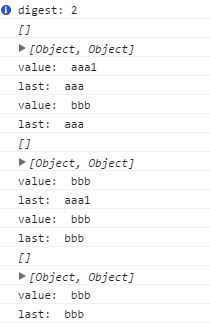angularjs系列之双向绑定
Posted
tags:
篇首语:本文由小常识网(cha138.com)小编为大家整理,主要介绍了angularjs系列之双向绑定相关的知识,希望对你有一定的参考价值。
把之前学到ng的一些东西和大家分享一下。首先要讲的就是ng最重要的一个特性,双向绑定。(angular源码全部是1.5.0版本)
那么一个双向绑定的代码是什么样子。来看ng官网上的例子,代码就是这么简单。
<script> angular.module(‘bindExample‘, []) .controller(‘ExampleController‘, [‘$scope‘, function($scope) { $scope.test = ‘Whirled‘;
$scope.testFn = function(){
console.log($scope.test);
}; }]); </script> <div ng-controller="ExampleController"> Enter name: <input type="text" ng-model="test"><br> Hello <span ng-bind="test"></span>! <span>{{test}}</span> <button class="btn btn-default" ng-click="testFn()">点击</button> </div>
但是ng是如何实现双向绑定?我们可以看到双向绑定的都是在$scope的属性。而$scope是$rootScopeProvider生成的一个实例。在ng代码中中,Scope原型链上主要有以下几个方法:
$new,$digest,$watch,$watchGroup,$watchCollection,$apply,$destroy,$eval,$on,$emit,$broadcast。
具体就不一 一介绍了。和数据绑定相关的主要有三个(类)。
- $digest
- $watch,$watchGroup,$watchCollection
- $apply
从Scope构造函数开始,看看它的几个实例属性
function Scope() {
this.$id = nextUid();
this.$$phase = this.$parent = this.$$watchers =
this.$$nextSibling = this.$$prevSibling =
this.$$childHead = this.$$childTail = null;
this.$root = this;
this.$$destroyed = false;
this.$$listeners = {};
this.$$listenerCount = {};
this.$$watchersCount = 0;
this.$$isolateBindings = null;
}
然后我们从最重要的$digest 入手,$digest是scope进行脏检查的核心部分,主要功能就是对scope.wathers数组的元素进行检查,更新watch。
核心代码如下:
$digest: function() {
var watch, value, last, fn, get,
watchers, //脏检查的对象数组
length,
//TTL 默认的脏检查循环上线,var TTL = 10; 可以修改digestTtl(15);
dirty, ttl = TTL,
next, current, target = this, //this scope的实例
watchLog = [],
logIdx, logMsg, asyncTask;
beginPhase(‘$digest‘); //设置脏检查的状态
// Check for changes to browser url that happened in sync before the call to $digest
$browser.$$checkUrlChange();
if (this === $rootScope && applyAsyncId !== null) {
// If this is the root scope, and $applyAsync has scheduled a deferred $apply(), then
// cancel the scheduled $apply and flush the queue of expressions to be evaluated.
$browser.defer.cancel(applyAsyncId);
flushApplyAsync();
}
lastDirtyWatch = null;
__i = __i + 1;
console.info(‘digest: ‘+__i);
do { // "while dirty" loop
dirty = false;
current = target;
while (asyncQueue.length) {
try {
asyncTask = asyncQueue.shift();
asyncTask.scope.$eval(asyncTask.expression, asyncTask.locals);
} catch (e) {
$exceptionHandler(e);
}
lastDirtyWatch = null;
}
traverseScopesLoop:
do { // 整个脏检查从这里开始
if ((watchers = current.$$watchers)) {
// console.log(watchers);
// process our watches
length = watchers.length;
while (length--) {
try {
watch = watchers[length];
// Most common watches are on primitives, in which case we can short
// circuit it with === operator, only when === fails do we use .equals
if (watch) {
get = watch.get;
// console.log(‘value: ‘+get(current));
//console.log(‘last: ‘+watch.last)
//value watch中当前的数据值,last watch中存储的上一次的数据值 watch.eq 是否开启对象的监听
if ((value = get(current)) !== (last = watch.last) &&
!(watch.eq
? equals(value, last)
: (typeof value === ‘number‘ && typeof last === ‘number‘
&& isNaN(value) && isNaN(last)))) {
dirty = true;
lastDirtyWatch = watch; // $digest触发的最后一个watch。为何呢?看下边
watch.last = watch.eq ? copy(value, null) : value;
fn = watch.fn;
fn(value, ((last === initWatchVal) ? value : last), current); //调用监听函数
if (ttl < 5) {
logIdx = 4 - ttl;
if (!watchLog[logIdx]) watchLog[logIdx] = [];
watchLog[logIdx].push({
msg: isFunction(watch.exp) ? ‘fn: ‘ + (watch.exp.name || watch.exp.toString()) : watch.exp,
newVal: value,
oldVal: last
});
}
} else if (watch === lastDirtyWatch) {
//因为digest至少会触发两次,找到有watch等于之前标记的最后一个脏检查的watch就停止脏检查
//这样做还有一个附带的好处就是当找到最后标记的那个watch,就跳出循环,不会对之后没有改变的watch进行处理
dirty = false;
break traverseScopesLoop;
}
}
} catch (e) {
$exceptionHandler(e);
}
}
}
// 这段代码作用是深度遍历,
if (!(next = ((current.$$watchersCount && current.$$childHead) ||
(current !== target && current.$$nextSibling)))) {
while (current !== target && !(next = current.$$nextSibling)) {
current = current.$parent;
}
}
} while ((current = next));
// `break traverseScopesLoop;` takes us to here
if ((dirty || asyncQueue.length) && !(ttl--)) {
clearPhase();
throw $rootScopeMinErr(‘infdig‘,
‘{0} $digest() iterations reached. Aborting!\n‘ +
‘Watchers fired in the last 5 iterations: {1}‘,
TTL, watchLog);
}
} while (dirty || asyncQueue.length);
clearPhase();
while (postDigestQueue.length) {
try {
postDigestQueue.shift()();
} catch (e) {
$exceptionHandler(e);
}
}
}
以上代码,我们需要着重关注,do {...} while (dirty || asyncQueue.length);这是整个digest循环,细节请看代码里边都有注释。大家可能会疑惑,为何需要两次digest。原因很简单,就是保证digest后边的watcher的改变没有影响到前边的watcher,起一个验证的作用。下边就是一个例子:
//html <input type="text" ng-model="test"/> //js $scope.test ="aaa"; $scope.$watch(‘test‘,function(value,last){
//对model的数据进行filter处理,尽量不要这样做,因为ngModelController有相应的方法。这里只是一个例子 if(value !== last){ $scope.test ="bbb"; } });
以上例子,当我们改变input时,digest就会触发,三次。

当然,代码稍作修改 $scope.test = $scope.test + ‘1‘; 这样digest会超过十次,error。
了解了如何做脏检查,那么我们就继续了解一下,如何向脏检查的watchers中注册被观察对象,主要有两类:
- {{}},ngBind,ngHide.....
- $watch()
第一种注册的过程:
- compile时,搜集directive
- link阶段,使用$watch()绑定
以{{}}为例
//收集directive的代码。根据nodeType来进行添加directive
function collectDirectives(node, directives, attrs, maxPriority, ignoreDirective) {
var nodeType = node.nodeType,
attrsMap = attrs.$attr,
match,
className;
switch (nodeType) {
case NODE_TYPE_TEXT: //对text进行处理
if (msie === 11) {
// Workaround for #11781
while (node.parentNode && node.nextSibling && node.nextSibling.nodeType === NODE_TYPE_TEXT) {
node.nodeValue = node.nodeValue + node.nextSibling.nodeValue;
node.parentNode.removeChild(node.nextSibling);
}
}
addTextInterpolateDirective(directives, node.nodeValue);
}
}
// {{}}指令
function addTextInterpolateDirective(directives, text) {
var interpolateFn = $interpolate(text, true);
if (interpolateFn) {
directives.push({
priority: 0,
compile: function textInterpolateCompileFn(templateNode) {
var templateNodeParent = templateNode.parent(),
hasCompileParent = !!templateNodeParent.length;
// When transcluding a template that has bindings in the root
// we don‘t have a parent and thus need to add the class during linking fn.
if (hasCompileParent) compile.$$addBindingClass(templateNodeParent);
return function textInterpolateLinkFn(scope, node) {
var parent = node.parent();
if (!hasCompileParent) compile.$$addBindingClass(parent);
compile.$$addBindingInfo(parent, interpolateFn.expressions);
//通过$watch添加监听
scope.$watch(interpolateFn, function interpolateFnWatchAction(value) {
node[0].nodeValue = value;
});
};
}
});
}
}
接下来就需要聊一聊$watch了。毕竟部分指令和手动注册watch都是通过这个方法。还是看源码
$watch: function(watchExp, listener, objectEquality, prettyPrintExpression) { var get = $parse(watchExp); //$parse转换 if (get.$$watchDelegate) { //如果已经注册watch了,进行移除watch操作 return get.$$watchDelegate(this, listener, objectEquality, get, watchExp); } var scope = this, array = scope.$$watchers, watcher = { fn: listener, last: initWatchVal, get: get, exp: prettyPrintExpression || watchExp, eq: !!objectEquality }; lastDirtyWatch = null; if (!isFunction(listener)) { watcher.fn = noop; } if (!array) { array = scope.$$watchers = []; } //unshift 是因为,digest的时候是length--,所以注册到watchers数组前 array.unshift(watcher); incrementWatchersCount(this, 1); //修改watchersCount数量 return function deregisterWatch() { if (arrayRemove(array, watcher) >= 0) { incrementWatchersCount(scope, -1); } lastDirtyWatch = null; //删除脏检查watch,防止死循环 }; },
$watchGroup,$watchCollection则是$watch的扩展,主要是对数组和对象的属性发生变化的监听。具体怎么用,大家可以去尝试,就不做介绍了。
当然,常常我们还会遇到$apply(),手动触发$digest循环。代码很简单。就不介绍了。
在angular中,脏检查占用了js运算的很大一部分,尤其是做下拉无线列表时,往往会绑定大量元素。这时候就需要考虑减少$watch,减少digest循环。比如bindonce就是将元素绑定到页面后注销watch。
以上是关于angularjs系列之双向绑定的主要内容,如果未能解决你的问题,请参考以下文章